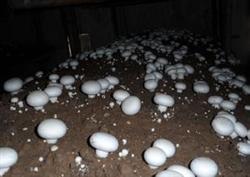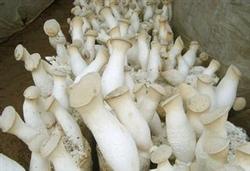Key points of Management of Pleurotus ostreatus shed in Autumn and Winter

When there are good bacteria in the material layer of Pleurotus ostreatus, only the reticular hyphae in the covered soil layer can produce good mushrooms and more mushrooms, so the management of bacteria in the covered soil layer is very important, even higher than that in the material layer. 1. When the covering soil is well watered and the water marks on the surface of the soil layer are removed, the temperature in the shed is maintained at 22 ℃-23 ℃, and the relative humidity is about 85%. Within 5 days, it is mainly to cover the doors and windows with little ventilation, supplemented by proper ventilation, so that the mycelium in the material can climb into the soil layer as soon as possible. In general, the hyphae can climb into the soil layer 5 days after covering the soil, and the ventilation rate increases gradually after 5 days, but the air volume should be determined by the mycelium state. If the hyphae are gray and white, it indicates that the ventilation is moderate. If the hyphae are fine and white, it indicates that the ventilation is not enough, in order to increase the times and time of ventilation. However, it is also necessary to prevent the hyphae from falling back due to excessive ventilation and forming deep underground mushrooms in the lower part of the soil layer. At the same time, once the mycelium climbs into the soil layer, it is generally not suitable to spray water again, because improper water spraying may also make the mycelium bow its head and produce mine mushrooms. In addition, pay attention to the temperature at night, if the temperature at night is less than 20 ℃, and the mycelium has just climbed into the soil layer, do not ventilate; if the soil is too dry and is not conducive to the mycelium string of soil, you should also spray water properly and spray frequently to adjust the soil layer to the appropriate humidity; if the hyphae have not climbed into the soil layer 5 days after covering the soil, you can cover the bacterial bed with a plastic film to facilitate hanging bacteria into the soil. 2. 15-20 days after soil mulching is the critical period of management. When the mycelium string reaches the overlying soil layer 2GP3 and a large number of hyphae appear in the soil layer, the ventilation rate should be increased in time, the greenhouse temperature should be adjusted to 16-18 ℃, and the material temperature should be reduced to 15-19 ℃. At the same time, after 1-2 days of high ventilation, some mushroom water should be sprayed, and then large ventilation for 1-3 days, and then transferred to small ventilation to promote the formation of primordium and mushroom buds. Mushroom water should be sprayed to the soil to make it flat, rub it round and not stick your hands. When the young buds grow to the size of soybeans (4488, 18.00,0.40%), they should be sprayed with quality-preserving water once. After 4-6 days, the mushroom buds of soybean size can grow to 2.5-4cm diameter grade mushrooms. 3. Generally speaking, during the period of mushroom emergence, the humidity of the soil layer is flat, rubbed round, non-sticky, the ground does not disperse, and water can not leak into the material. If the humidity of the soil layer reaches the degree that it can rub round and stick hands, it indicates that the moisture is already high. If the mushrooms have been produced in October and the temperature is still high, the humidity of the soil layer can reach the level of rubbing round and slightly sticking hands when the first crop of mushrooms is produced. However, the humidity of the soil layer should not be allowed to reach the degree of slight stickiness in November, and the humidity of the soil layer should be reduced gradually to avoid water damage to the hyphae. 4. When the fungus cap grows to 3-4cm, the mushroom should be harvested in time, when the mushroom quality is good, the tide changes quickly, and the yield is high. If the harvest is too late, the mushroom body will grow too big, which will greatly delay the spread of moisture and will not increase the yield.
- Prev

How to prevent agaricus bisporus strain degradation
To prevent strain degeneration, can improve yield, reduce the occurrence and development of diseases and insect pests, reduce pesticide consumption, is the basis of organic Agaricus bisporus production. 1. The environmental temperature of cultured strains should not exceed 28 ℃, and the storage time of cultured strains at normal temperature should not exceed half a month. 2. The best way to get out of this is to get out of bed.
- Next

Several key problems should be grasped in cultivating Pleurotus eryngii
Pleurotus eryngii, also known as Pleurotus ostreatus, is one of the rare edible fungi. Its meat is thick, crisp and tender, milky white in color, delicious in taste and rich in nutrition. It is known as "meat in vegetarian". Using the following indoor and outdoor soil covering cultivation techniques, the biological biodegradability can reach 100%, 120%, and the mushroom body is commercial and not covered with soil.
Related
- Fuxing push coffee new agricultural production and marketing class: lack of small-scale processing plants
- Jujube rice field leisure farm deep ploughing Yilan for five years to create a space for organic food and play
- Nongyu Farm-A trial of organic papaya for brave women with advanced technology
- Four points for attention in the prevention and control of diseases and insect pests of edible fungi
- How to add nutrient solution to Edible Fungi
- Is there any good way to control edible fungus mites?
- Open Inoculation Technology of Edible Fungi
- Is there any clever way to use fertilizer for edible fungus in winter?
- What agents are used to kill the pathogens of edible fungi in the mushroom shed?
- Rapid drying of Edible Fungi

